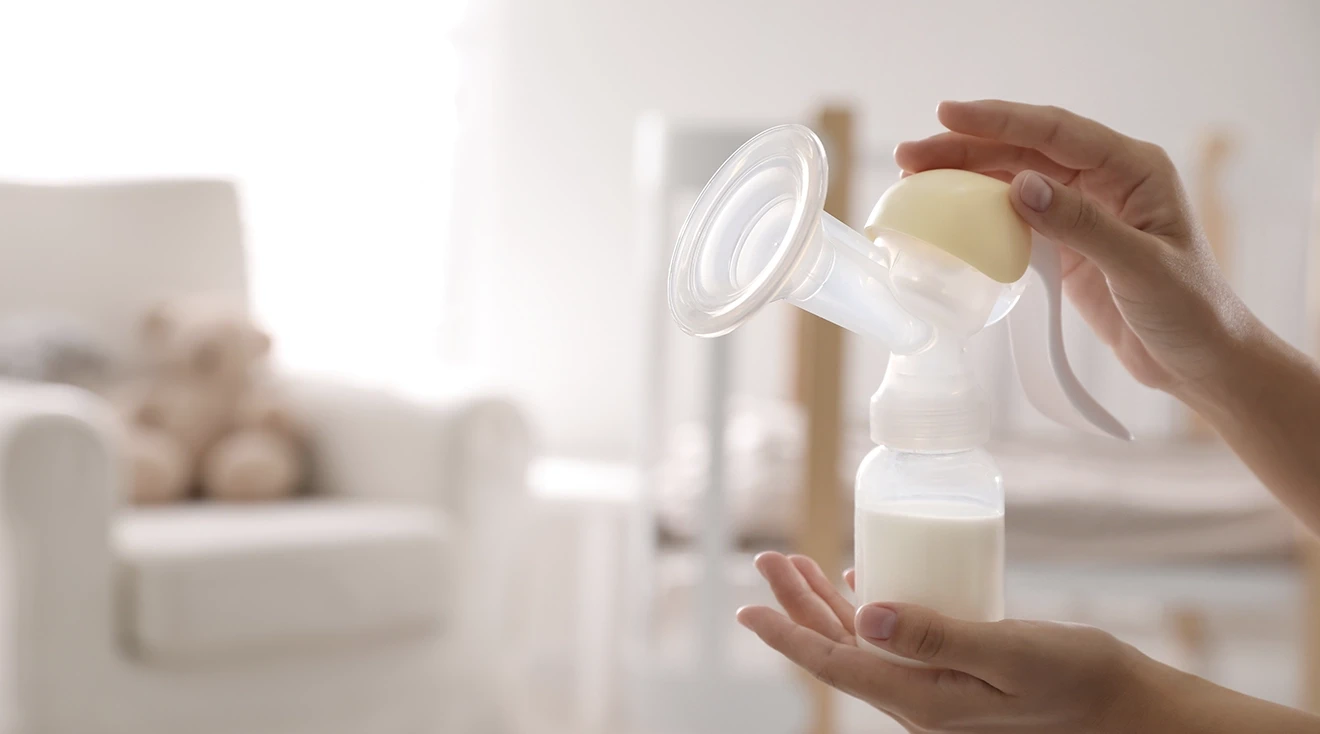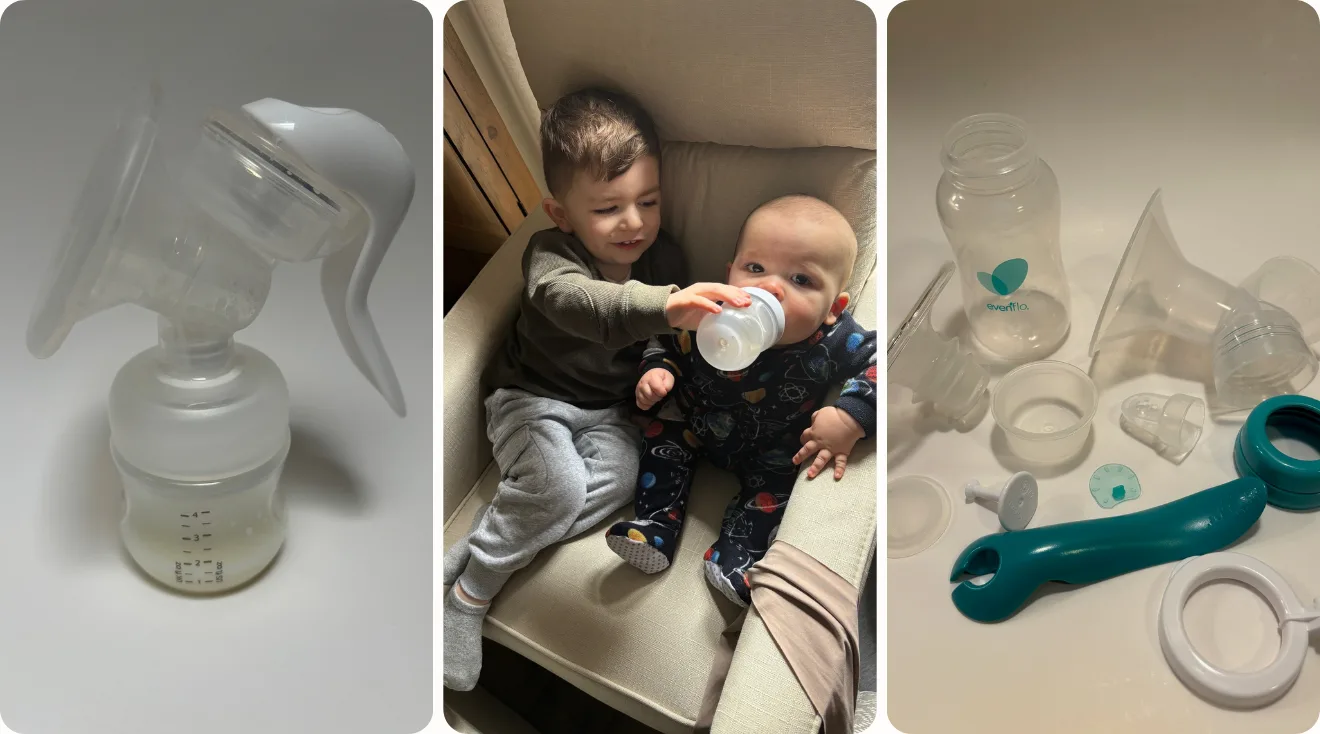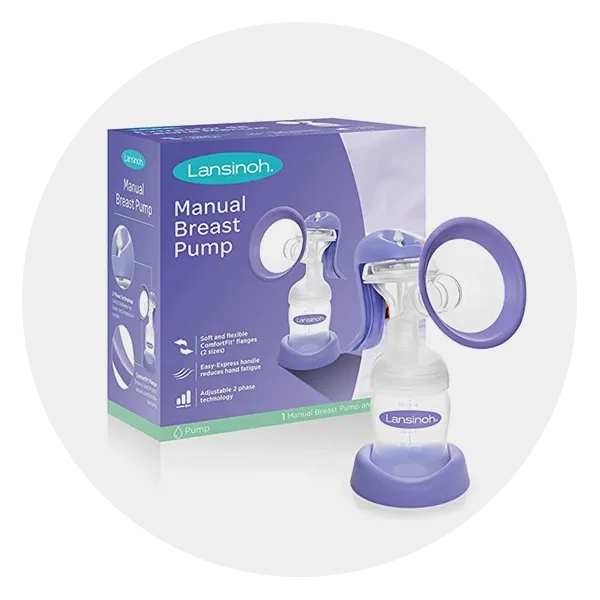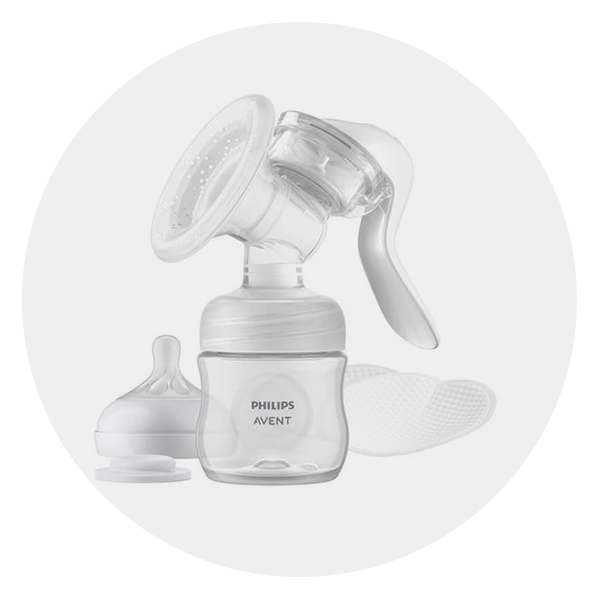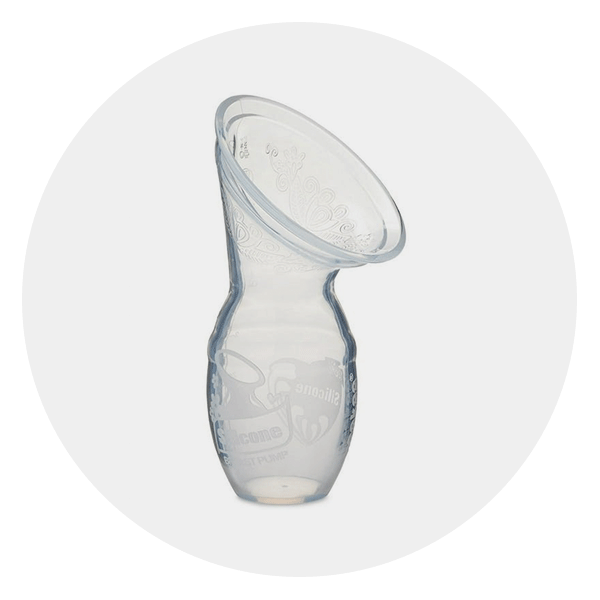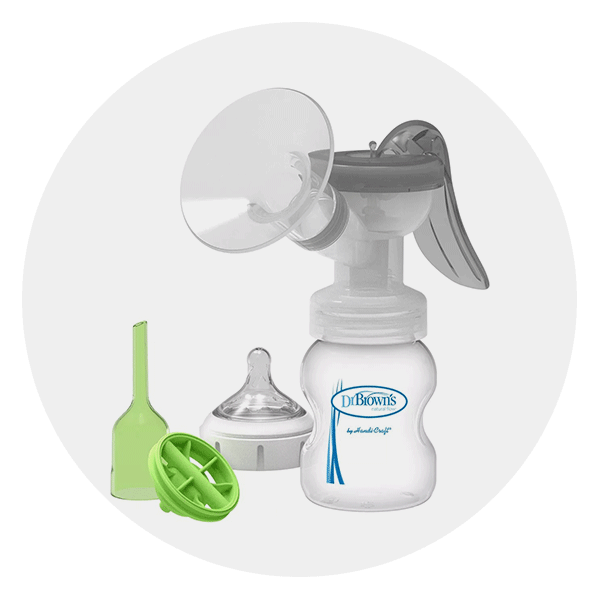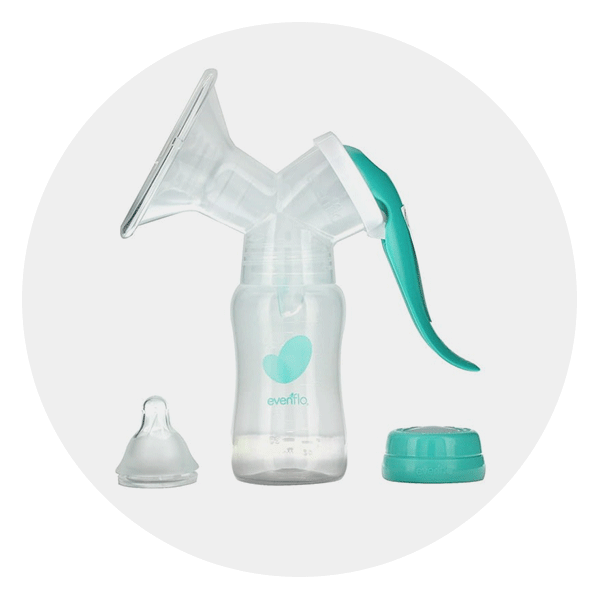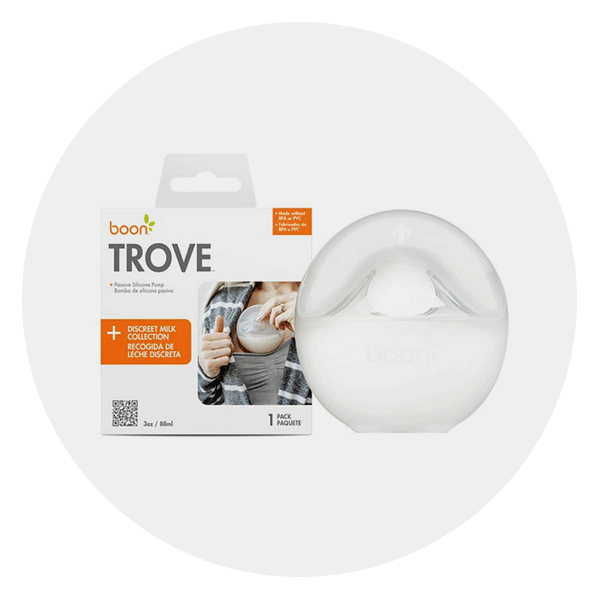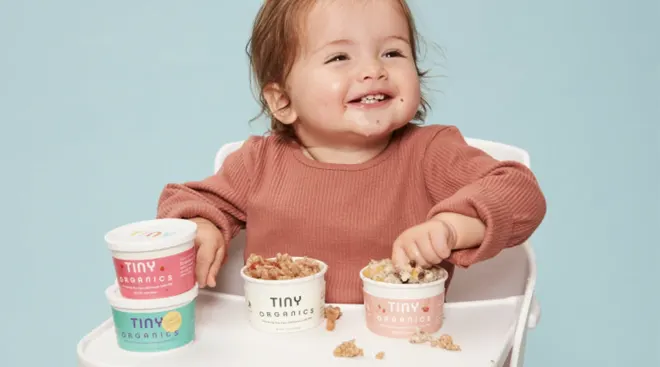6 Best Manual Breast Pumps, Hand-Tested
In a nutshell:
Based on product testing, advice from a lactation consultant and in-depth market research we chose the Lansinoh Manual Breast Pump as the overall best hand pump. It won out over the other options thanks to its easy to use design and high milk yield.
If you’re like most parents who choose to breastfeed baby, you may occasionally find yourself in a situation where you need to pump. After all, it’s nearly impossible to be with baby for every single feeding, especially as they get older. Then, there are those times when you’re feeling a bit full and need a quick way to express milk. For those times when you don’t want to set up your electric pump, a manual breast pump can come in handy.
“A manual pump is great for occasional or emergency use,” says Chrisie Rosenthal, IBCLC, a lactation consultant with the The Lactation Network. “It’s the perfect pump to keep in your bag for ‘pumping on-the-go’ situations where electricity may not be available, or when a full pumping session isn’t needed.”
If you don’t own a manual breast pump and you’ve considered adding one to your breastfeeding arsenal, you’ve come to the right place. I’m a mom of two little boys—a three-year-old and nine-month-old. While my breastfeeding journey with my first baby wasn’t successful due to a lack of support (he was born during the COVID-19 pandemic), my breastfeeding experience with my second son has been an absolute joy. Thanks to my positive nursing experience as a second-time mom, with the support of an IBCLC, I know a thing or two about breastfeeding. I also know that quality products can support and optimize a new mom’s breastfeeding experience. To help you determine which hand pump is worth purchasing I’ve tested several different options and worked with my colleagues at The Bump to select the best manual breast pumps on the market.
We took the following steps to find the best manual breast pumps on offer:
-
I, along with two other nursing moms, put several manual breast pumps through rigorous product testing. We evaluated each pump according to a set list of criteria including: ease of use, effectiveness, comfort, quality, value, style and design. We shared our testing results with The Bump editorial team and from there a shortlist of six hand pumps were selected for this roundup.
-
We interviewed a certified lactation consultant to understand essential features and considerations to keep top of mind when you’re shopping for a manual breast pump.
-
We leveraged our familiarity with leading nursing and pumping brands to make sure items are from reliable manufacturers. And since many of us are also parents, we rely on our editors’ experience using hand pumps during their own breastfeeding journeys.
-
To see how these manual pumps worked for a variety of women, we conducted exhaustive market research, scouring forums and message boards and reading user reviews to find out what parents across the country looked for in a hand pump.
Editorial integrity is at the heart of everything we publish. Read about how The Bump develops and reviews all articles, including product reviews.
Overall best manual breast pump
- Portable
- Soft, flexible rim
- Pump directly into bottle or milk storage bag
- Some moms complained of a squeaking noise
- Flange can fall out easily
Based on extensive research and product testing, the Lansinoh Manual Breast Pump was voted the overall best in show. (In fact, it was highlighted as the best manual breast pump in the 2023 Best of The Bump awards.) Its winner status is no surprise really, as the pump scored top points across every testing category. Easy to use? Check. Effective output? Check. Gentle on the breast? Check. Incredible value? Check. Quality materials and design? Double check.
But there are three key features that set this product apart from the competition: An ergonomic handle reduces hand fatigue and cramping, so you can pump for longer periods of time. You can easily pump directly into Lansinoh bottles or directly into the brand’s milk storage bags to ensure your milk stays sterile and you don’t waste a drop. And, most importantly, the flanges are designed with ComfortFit technology that actually cushions your breast to prevent nipple irritation during pumping sessions.
On the topic of flanges, moms love that this Lansinoh pump comes with two sizes—25 and 30.5 millimeters—to ensure the best fit possible. Our product tester noted that the different flange sizes made it very comfortable for her to express milk and said: “The effectiveness was wonderful. It brought my letdown almost right away.” And she’s not alone. Several moms felt that this model was so effective that it yielded more expressed milk than their electric breast pumps. Trust me, that’s a really big deal!
Lansinoh is composed of quality parts; soft silicone flanges and a sturdy base, which made pumping a breeze for our tester. Plus two pumping modes, stimulation and expression, support initial letdown and continuous pumping to maximize milk production. Each piece is easily cleaned on the top rack of your dishwasher; but the manufacturer recommends washing these components by hand to prevent damage and extend the usefulness of your breast pump.
Dimensions: 7.5″ (L) x 7.5″ (W) x 3.9″ (H) | Capacity: 5 oz. | Number of parts: 13 | Dishwasher safe: Yes
Our product tester says:
“In an emergency situation, I’m so glad to have this pump. It truly relieves anxiety.”
Best manual breast pump to stimulate milk flow
- Easy to clean
- Compatible with Philips Avent Natural bottles
- Silicone insert molds nicely to the breast
- Not hands-free
- Some parents say the pump handle was too small
Manual breast pumps aren't meant to replace electric breast pumps—in fact, doing so can affect milk supply. But after testing various products I found that the Philips Avent Manual Breast Pump yielded the most milk, making it a highly effective hand pump. The brand promises “natural motion technology for quick milk flow,” and it certainly lived up to this expectation. The letdown with this pump occurred almost instantaneously. I have a pretty quick letdown, and yet I was still impressed with how fast a manual pump could stimulate milk flow. Within one minute, I was filling the provided bottle with supplemental milk for my little one.
I was amazed at how quickly I was able to pump almost two ounces using this manual breast pump. In under five minutes, I had enough milk to fully supplement my baby's feeding. Pumping directly into a Philips Avent bottle made the process even simpler—I simply unscrewed the pump from the bottle when I was finished. I replaced the pump with the provided nipple and my husband (and older son!) could complete the feeding.
While this model isn't hands-free, I found it very easy to walk around and pump with one hand while I picked out clothes for my older son to get ready to go out. (As a mom of two, I have to get creative with multitasking!) I personally love that I can sit upright and pump without having to bend forward and strain my neck and upper back, which often is the case with my electric pump and nursing. Philips Avent has created a manual pump that’s gentle and mimics breastfeeding for a fantastic output, making a seamless transition from going back and forth from pumping to nursing. Safe to say, it’s a winner in my book.
Dimensions: 3.5″ (L) x 7.7″ (W) x 6″ (H) | Capacity: 4 oz. | Number of parts: 12 | Dishwasher safe: Yes
Our product tester says:
“This manual pump suctioned very comfortably to my breast. It was easy to center my nipple on the flange and it was painless to pump.”
Best silicone manual breast pump
- Lightweight and portable
- BPA-free food grade silicone
- Easy to clean
- Not fully wearable
- It can be difficult to suction with very engorged breasts
- Some parents say the rim is uncomfortable around the breast
Eco-friendly, compact, noiseless, gentle and effective; it’s no wonder the Haakaa made it onto our list of the best manual breast pumps. The food-grade silicone flange simply suctions onto one breast while you feed your baby with the other, effectively collecting the milk letdown that would otherwise go to waste. When I began my breastfeeding journey with my now 9-month-old, I used the Haakaa for collecting extra milk and stimulating letdown on one breast when baby was only feeding from one (which helped establish milk supply). The Haaka also helped my baby latch as the natural suction draws out nipples and softens breasts from engorgement, allowing baby to latch on more efficiently.
Another feature I love about the Haakaa silicone pump is that it requires no assembly, which also means it's easy to clean as there are no crevices for milk to get stuck or bacteria to grow. I love the portability, as well. I’ve stashed the Haakaa in my diaper bag as a staple and take it with me anywhere I need noiseless, quick relief. This little pump is what I call “almost” hands-free. It isn't wearable—as it doesn't secure in your bra—and even though it suctioned pretty well to my breast, I wasn't 100 percent confident in the suction adhering to my breast as it did slip a couple of times. I held onto it to avoid losing any precious expressed milk. The pump began collecting milk from my letdown as soon as I began nursing my son on the opposite breast. This manual breast pump was fantastic when I had an oversupply in my early breastfeeding days and my bra would get soaked with milk. I was able to salvage any extra milk by either bottle-feeding my baby or storing it in milk storage bags and freezing it for later use.
In addition, my lactation consultant informed me that the Haakaa is wonderful at removing clogs from milk ducts! Moms can simply fill the pump with warm water and epsom salts to gently release stubborn clogs. This is truly the little silicone pump that does it all.
Dimensions: 5.7″ (L) x 2.2″ (W) x 3.4″ (H) (flange diameter) | Capacity: 4 oz. | Number of parts: 1 | Dishwasher safe: Yes
Our product tester says:
“The curved shape makes pouring expressed breast milk into bottles and storage bags seamless and easy.”
Best manual breast pump for working moms
- Lightweight and portable
- No hand-cramping when pumping
- Pump directly into Dr. Brown’s bottles
- Multiple parts to clean
- Some parents felt that two hands were needed to operate the pump
Dr. Brown’s is a manufacturer I’ve come to know and trust in my motherhood journey. My older son struggled with a tongue-tie, difficulty latching and severe reflux. Dr. Brown’s products have been reliable from the very beginning, so I was eager to put the brand’s manual breast pump to the test. Needless to say—with all of the features you'd want for a quick expression session in the car or even at your office—it won out as the best manual pump for working moms.
I’m a mom of two and a freelance writer, and this lightweight pump packs up so nicely into my diaper bag for meetings or interviews on the go. The included anti-colic bottle system is a game-changer as I don't have to transfer any milk when I need to feed my baby outside of my home. The storage cap makes it simple to store milk in a cooler or work fridge without having to pour the milk into separate bags or containers.
Another of my favorite features is the One-piece SoftShape Silicone Shield. Even though I found the shield to be sturdy and robust, the flange was comfortable and seemed to mold to fit my breast. The silicone flange transparency also made it so much easier to see when my milk let down and when to cease a pumping session, as milk production begins to slow down.
I especially loved how the pump could be adjusted to mimic two different feeding speeds, much like when my baby breastfeeds. Setting the initial speed to quick, short bursts of movement to stimulate letdown, and then adjusting to longer pumps to imitate how babies relax into their feedings once milk is flowing.
Dimensions: 4.5″ (L) x 8.3″ (W) x 7.8″ (H) (flange diameter) | Capacity: 5 oz. | Number of parts: 14 | Dishwasher safe: Yes
Our product tester says:
“While the materials are lightweight (a bonus when packing in your diaper bag), they feel like the same quality materials that I've come to know and trust from Dr. Browns. The silicone shield is thick yet flexible, the parts feel durable and it seems they will be long-lasting.”
Best manual breast pump for comfort
- Multiple flange sizes
- Interchangeable parts with Evenflo products
- Pump directly into the Evenflo bottle
- Some parents said the suction wasn’t strong enough
If you're searching for comfort look no further than the Advanced Manual Breast Pump by Evenflo Feeding. I began pumping with short, quick pumps to stimulate letdown, which occurred very quickly (about 20 to 30 seconds if not engorged, and almost instantly with engorgement). After transitioning to slow, even pumps, I was able to collect about 1.5 ounces in under 5 minutes, which is a decent amount of milk for me. I used this pump both while nursing my baby on the opposite breast and in the morning to relieve an engorged breast and it was effective in both scenarios. What made it so special for both instances? The comfort. This is due to the fact that this manual breast pump comes with multiple flange sizes. With an engorged breast, I didn’t need the provided silicone insert and pumped with the plastic flange only (30.5 millimeter). When I pumped while I nursed my baby on the opposite breast, I wasn’t as full of milk and therefore loved the 24.5 millimeter silicone insert for a tighter fit. In both cases, comfort was of the utmost, and yet I still yielded anywhere from 1.5 to 2 ounces of milk.
Another feature I enjoyed with this manual breast pump is the teal-colored handle. Not only is it aesthetically pleasing it’s also functional, as it makes it easier to find and grab the pump from inside my diaper bag. I also love that the handle of this pump pivots, allowing you to pump with either hand. This made it very easy to hold my baby and nurse him on one side, while I pumped the other side, another feature that added to the comfort of my pump—no hand cramping!
Dimensions: 5.4″ (L) x 5.5″ (W) x 8.5″ (H) | Capacity: 5 oz. | Number of parts: 11 | Dishwasher safe: Yes
Our product tester says:
“I easily found a speed and strength level that was both effective in collecting my milk and very comfortable.”
Best wearable manual breast pump
- Can’t be kicked off by baby nursing on the opposite breast
- Easy to pour milk into bottles and storage bags
- Stands upright on a table
- No lid or seal option
- Some moms felt it wasn’t discreet enough for public use
- Some people felt it only worked on engorged breasts
Picture this—you’ve got your youngest in one arm, serving your toddler breakfast with your “free” hand and because your baby is finally sleeping stretches longer than two hours at a time, one breast is completely engorged with milk. Your toddler isn’t going to wait and you can’t sit and pump: You need something completely hands-free. This is a typical scenario in my house! Enter Boon Trove, a completely wearable, silicone breast pump that fits securely inside a nursing bra. This pump offers relief when I really need it, and the fact that it’s wearable makes it an incredibly functional breastfeeding accessory.
Let’s face it breast milk is called liquid gold for a reason—and when you don’t get a chance to pump at the moment you need to or when nursing baby on one side—often the other breast will leak, wasting precious milk that soaks your bra or a nursing pad.
While Boon Trove is similar to the Haakaa pump in that it collects milk letdown, I especially loved that it is a wearable silicone option that stays on the breast secured inside my bra, ensuring no spillage. Even when my baby was kicking with joy during his feedings, Boon Trove stayed put. And, as it’s intended to collect passive milk flow, it doesn’t create an oversupply like other silicone milk catchers. This little silicone wonder is designed with functionality and ease of use in mind. I love that you can squeeze the sides to easily pour the milk into bottles or milk bags—this is such a bonus. It’s a thoughtfully designed, stylish-looking product whereby minimalist design meets maximum functionality.
Dimensions: 2.1″ (L) x 4″ (W) x 4.1″ (H) | Capacity: 3 oz. | Number of parts: 1 | Dishwasher safe: Yes
Our product tester says:
“It is so easy to slip into my diaper bag without lots of cumbersome parts and it cleans beautifully.”
While manual and electric breast pumps both work to express breast milk, they function a bit differently. An electric breast pump needs batteries or a mains connection in order to operate and provides an automatic motion that simulates a baby’s nursing actions, prompting letdown. In contrast, a manual breast pump doesn’t need batteries or electricity. Instead it functions using a mechanical motion, either by hand pumping or with natural suction.
Pros and cons of manual vs. electric breast pumps
Many parents find that they get better milk removal with an electric pump. “A high-quality double-electric pump is the standard for regular milk removal,” says Rosenthal. Not only do electric pumps boast powerful suction, but double-style models also allow you to drain both breasts at the same time, which cuts down on the amount of time spent pumping. Plus, modern hands-free models can often be worn inside a pumping bra for discreet sessions on-the-go. If you use a manual breast pump, you may have to continuously squeeze the pump handle (depending on the type). “They also tend to be more aggressive on a parent’s nipples, which can lead to sore nipples.”
That said, manual pumps are superstars when it comes to portability. “Their small size and lower price make them great for travel and occasional use, and the ability to use the pump without electricity is another plus,” says Rosenthal. Ultimately, moms love manual breast pumps for their affordability, portability and the ability to use them wherever, whenever, without having to worry about recharging or staying close to an outlet.
In the past, the term “manual breast pump” was used to indicate the type of pump that has to be squeezed by hand in order to express milk. In recent years though, other types of pumps have emerged that don’t require any active pumping. Here’s a quick breakdown of the various types of manual breast pumps:
- Handle pumps. This classic style is operated by manually squeezing a handle or lever to create suction, which pulls and releases your nipples and draws out milk using vacuum pressure, just as baby naturally does.
- Silicone pumps. These pumps also use suction to actively remove milk, Rosenthal explains, but they don’t call for continuous hand-pumping—once you establish suction with an initial squeeze, and the pump relies on vacuum suction to allow some milk to be drained. They’re often used to collect milk from one breast while baby nurses from the other.
- Milk catchers. This type of pump doesn’t require any pumping—rather, it collects milk that otherwise would leak into your bra or nursing pad. “Milk catchers fit inside the bra, up against the breast and are entirely passive, collecting milk that drips or leaks from the breast between breastfeeds or pump sessions.”
Wondering how to actually use a manual breast pump? Of course, it will depend on the type of pump you’re using. Take a look at our step-by-step guides below.
Handle pump
- Align the flange so your nipple is directly in the center of the tunnel.
- With the bottle attached, gently press down on the handle repeatedly until milk begins to flow.
- For a two-phase expression pump, press down on the handle and hold for one to two seconds, then release to get the most milk during the letdown phase.
Silicone pump
- Squeeze the pump to release air inside it.
- Still squeezing the pump, attach it to your breast.
- Release your grip on the bottle, which allows it to suction to your breast.
Milk catcher
- Align the opening with your nipple.
- Place inside your bra (for most models).
- Allow the milk catcher to collect the milk that leaks from your breast.
My top tips as a mom of two
In addition, here are some tips I personally found helpful when using a manual breast pump:
- Make sure your hands and all pump parts are clean and dry before handling the manual breast pump
- Gently massaging your breast can help with letdown—so can being around your baby or looking at a photo of them. When I’ve had to pump while being away from my son, I find it helpful to think about his cute little face or pull up a picture of him on my phone. Doing so can release oxytocin and help with letdown!
- Try to mimic baby’s feeding with the speed at which you pump. While breastfeeding, babies begin with quick sucking motions and then transition to more even, slower sucking once milk is flowing. It can be helpful (if you are using a handle pump) to imitate this with the speed of your pumps.
About the writer:
Christine Carpenter is a storyteller from New York. She approaches her craft intending to make women feel less alone in motherhood. Carpenter’s favorite job is being a mama of two little boys; her toddler, Cole, and baby, Rylan. With over a decade of experience in the fashion industry, she has a rich professional background in Product Development and a full-blown obsession with products that make life easier and more fun! Carpenter has an eye for quality and experience managing all steps of the product supply chain from inception to delivery. Her writing has been published in Motherscope, The Kindred Voice, and Mantra Wellness, among others.
Interested in becoming a product tester for The Bump? Head here to apply.
Please note: The Bump and the materials and information it contains are not intended to, and do not constitute, medical or other health advice or diagnosis and should not be used as such. You should always consult with a qualified physician or health professional about your specific circumstances.
Plus, more from The Bump:
Chrisie Rosenthal, IBCLC, is a lactation consultant with The Lactation Network, a mission-driven company that connects families with insurance-covered breast pumps and lactation consultations during pregnancy and postpartum. She obtained her IBCLC through the UCSD Lactation Consultant program. Rosenthal is the owner of The Land of Milk and Mommy, a private practice in Woodland Hills, California. She is also the author of two books,Lactivate! A User’s Guide to Breastfeeding and The First-Time Mom’s Breastfeeding Handbook: A Step-by-Step Guide From First Latch to Weaning.
Navigate forward to interact with the calendar and select a date. Press the question mark key to get the keyboard shortcuts for changing dates.

































